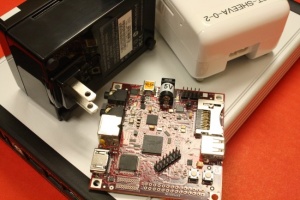From Fedora Project Wiki
m (Added shortcut link) |
|||
| Line 1: | Line 1: | ||
{{shortcut|Arch:ARM}} | |||
[[File:091-IMG_4134.JPG.medium.jpeg|right|300px|thumb|Examples of ARM develoment systems, including a SheevaPlug (white box), GuruPlug (black box), BeagleBoard (bare PCB), and OpenRD-Client (silver box). These systems typically consume under 5 watts each.]] | [[File:091-IMG_4134.JPG.medium.jpeg|right|300px|thumb|Examples of ARM develoment systems, including a SheevaPlug (white box), GuruPlug (black box), BeagleBoard (bare PCB), and OpenRD-Client (silver box). These systems typically consume under 5 watts each.]] | ||
= Introduction = | = Introduction = | ||
Revision as of 13:55, 22 January 2011

Introduction
ARM chips are the most widely-produced processor family in the world; they have historically been used in cell phones and embedded applications, and are increasingly used in tablet devices and low-power-consumption servers.
The Fedora-ARM project is an initiative to bring Fedora to this processor family.
Communication
- Mailing list: arm@lists.fedoraproject.org (archives)
- IRC: #fedora-arm on Freenode
Resources
Detailed information on Fedora-ARM:
- Running Fedora-ARM on your ARM device, or through emulation on your PC
- Information for Fedora package maintainers on getting your packages to work on ARM
- Information for Fedora-ARM team members (and prospective team members!) plus developers
- How to get an armv5tel cross toolchain installed on your x86 Fedora host
- How to build a kernel and cross-compile for ARM
